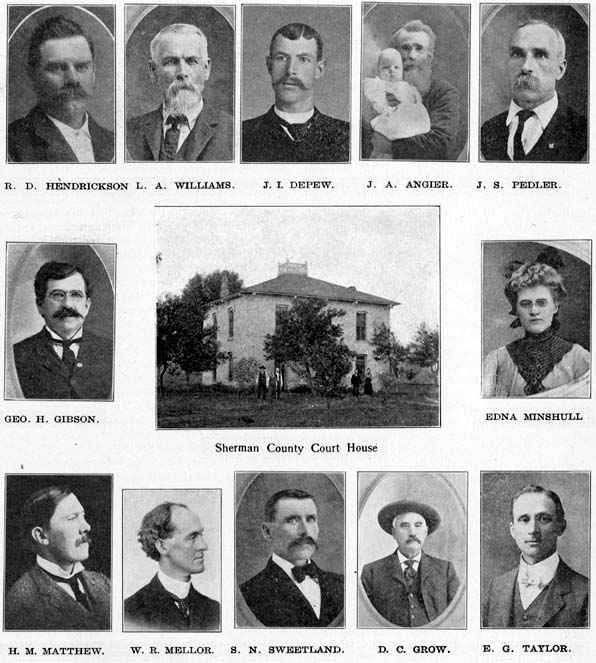steaded in Sheridan County. On March 22, 1892,
he was married to Miss Phoebe Haskin. Mr. Housh is a
member of the Populist party and has been elected Sheriff
of Sheridan County for the fourth term.
I. R. BRAY was
born December 25, 1852, in Green County, Wisconsin, and
came to Hamilton County, Nebraska, in 1872. He settled in
Sheridan County in 1884. Mr. Bray has eight hundred acres
of deeded land in Sheridan County and is the proprietor
of the Commercial Hotel of Hay Springs. He is a
Republican and is serving his second term as County
Commissioner.
P. T. JOHNSON
was born in Norway, December 14, 1850. In 1869 he came to
the United States and came to Sheridan County, Nebraska,
in 1885. June 28, 1876, at Norway, Iowa, he was married
to Miss Minnie Tow, who died in 1887. Mr. Johnson has a
stock farm and was formerly engaged in the implement
business. He is a Populist and is now serving his second
term as County Commissioner.
MABEL PEARL VAN
FLECK was born in Saunders County, Nebraska, May 18,
1884, and the next year her parents moved to Sheridan
County. She graduated from the Rushville High School in
1900 and since that time has been Deputy Clerk of
Sheridan County. Her parents were among the early
settlers and her father is a veteran of the Civil War,
having been a member of Company F of the Sixty-fourth
Illinois Regiment.
AMOS BURWELL was
born at Lowden, Iowa, May 6, 1859. He attended Cornell
College for two years and then began as an agent operator
for the Northwestern Railroad, in the service of which he
remained for eighteen years. In 1883 he was transferred
to Nebraska. He was interested in the banking arid
mercantile business before coming to Rushville. In 1888
he married Miss Mary Connor. He is a Republican and has
been appointed Deputy Treasurer of Sheridan County.
CHARLES P.
BREESE, the first white man now living to go through
what is now Sheridan County, was born in Council Bluffs,
Iowa, January 26, 1861. His father was a government
blacksmith of the Indian reservation at Genoa, Nebraska,
and then moved to Butler County. When a boy of fifteen
Mr. Bresee went to the mountains and was engaged in
freighting and mining in the Black Hills and Idaho for
six years, when he returned to Butler County and was
there married to Miss Annie Edgar in 1885. In 1885 he
homesteaded in Sheridan County. He is Secretary and
Treasurer of the Maverick Loan and Trust Company, is a
Republican and was Judge of Sheridan County for four
years.
W. H. WESTOVER
was born in Delaware County, Iowa, March 19, 1858. In
1870 he came to Lincoln, Nebraska 'where he received his
education in the High School and the State University. In
1877 he went to David City, Nebraska, and studied law
while teaching school in Butler County, having begun the
study of law in the office of E. E. Brown of Lincoln. He
was admitted to the bar in 1879 at the age of twenty-one.
He came to Sheridan County in 1885 and took a homestead
there, which he still holds. In 1879 he was married to
Miss Olive C. Paschal of Burlington, Iowa, and they have
ten children. Judge Westover served two terms as Attorney
of Sheridan County and is now serving his third term as
Judge of the Fifteenth Judicial District.




